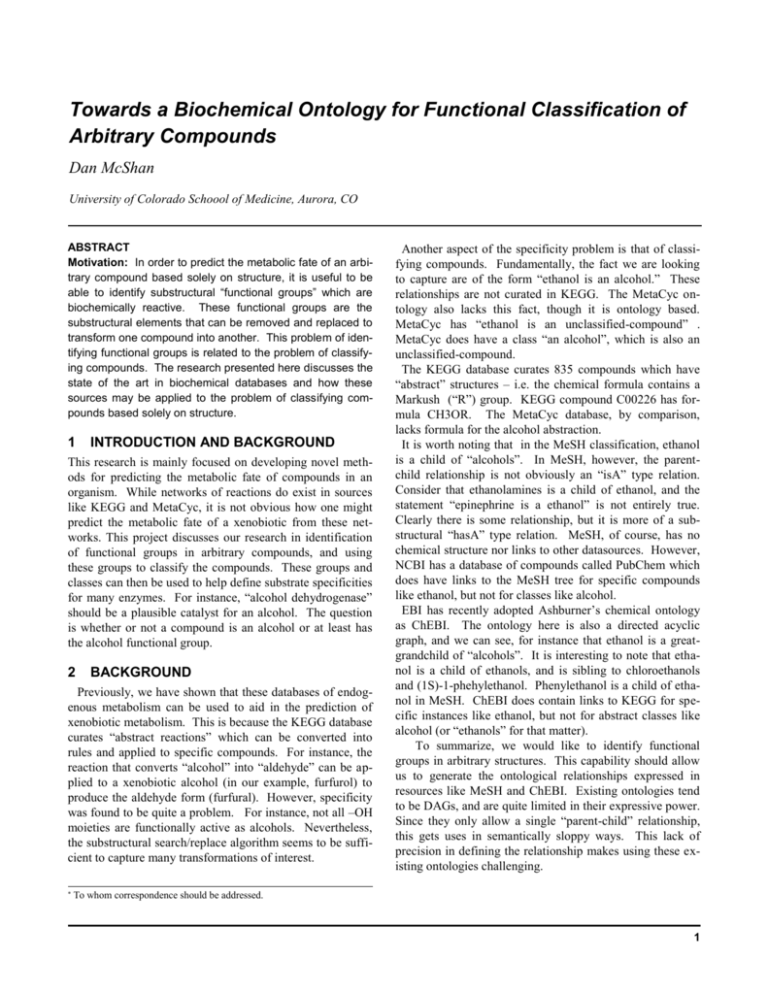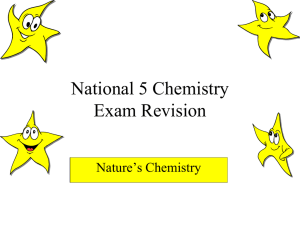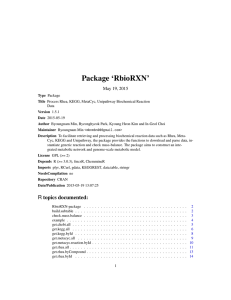doc
advertisement

Towards a Biochemical Ontology for Functional Classification of Arbitrary Compounds Dan McShan University of Colorado Schoool of Medicine, Aurora, CO ABSTRACT Motivation: In order to predict the metabolic fate of an arbitrary compound based solely on structure, it is useful to be able to identify substructural “functional groups” which are biochemically reactive. These functional groups are the substructural elements that can be removed and replaced to transform one compound into another. This problem of identifying functional groups is related to the problem of classifying compounds. The research presented here discusses the state of the art in biochemical databases and how these sources may be applied to the problem of classifying compounds based solely on structure. 1 INTRODUCTION AND BACKGROUND This research is mainly focused on developing novel methods for predicting the metabolic fate of compounds in an organism. While networks of reactions do exist in sources like KEGG and MetaCyc, it is not obvious how one might predict the metabolic fate of a xenobiotic from these networks. This project discusses our research in identification of functional groups in arbitrary compounds, and using these groups to classify the compounds. These groups and classes can then be used to help define substrate specificities for many enzymes. For instance, “alcohol dehydrogenase” should be a plausible catalyst for an alcohol. The question is whether or not a compound is an alcohol or at least has the alcohol functional group. 2 BACKGROUND Previously, we have shown that these databases of endogenous metabolism can be used to aid in the prediction of xenobiotic metabolism. This is because the KEGG database curates “abstract reactions” which can be converted into rules and applied to specific compounds. For instance, the reaction that converts “alcohol” into “aldehyde” can be applied to a xenobiotic alcohol (in our example, furfurol) to produce the aldehyde form (furfural). However, specificity was found to be quite a problem. For instance, not all –OH moieties are functionally active as alcohols. Nevertheless, the substructural search/replace algorithm seems to be sufficient to capture many transformations of interest. * Another aspect of the specificity problem is that of classifying compounds. Fundamentally, the fact we are looking to capture are of the form “ethanol is an alcohol.” These relationships are not curated in KEGG. The MetaCyc ontology also lacks this fact, though it is ontology based. MetaCyc has “ethanol is an unclassified-compound” . MetaCyc does have a class “an alcohol”, which is also an unclassified-compound. The KEGG database curates 835 compounds which have “abstract” structures – i.e. the chemical formula contains a Markush (“R”) group. KEGG compound C00226 has formula CH3OR. The MetaCyc database, by comparison, lacks formula for the alcohol abstraction. It is worth noting that in the MeSH classification, ethanol is a child of “alcohols”. In MeSH, however, the parentchild relationship is not obviously an “isA” type relation. Consider that ethanolamines is a child of ethanol, and the statement “epinephrine is a ethanol” is not entirely true. Clearly there is some relationship, but it is more of a substructural “hasA” type relation. MeSH, of course, has no chemical structure nor links to other datasources. However, NCBI has a database of compounds called PubChem which does have links to the MeSH tree for specific compounds like ethanol, but not for classes like alcohol. EBI has recently adopted Ashburner’s chemical ontology as ChEBI. The ontology here is also a directed acyclic graph, and we can see, for instance that ethanol is a greatgrandchild of “alcohols”. It is interesting to note that ethanol is a child of ethanols, and is sibling to chloroethanols and (1S)-1-phehylethanol. Phenylethanol is a child of ethanol in MeSH. ChEBI does contain links to KEGG for specific instances like ethanol, but not for abstract classes like alcohol (or “ethanols” for that matter). To summarize, we would like to identify functional groups in arbitrary structures. This capability should allow us to generate the ontological relationships expressed in resources like MeSH and ChEBI. Existing ontologies tend to be DAGs, and are quite limited in their expressive power. Since they only allow a single “parent-child” relationship, this gets uses in semantically sloppy ways. This lack of precision in defining the relationship makes using these existing ontologies challenging. To whom correspondence should be addressed. 1 D.McShan 3 APPROACH Our approach is to integrate the above databases in a single ontology. Using the compound structures from KEGG and PubChem, we intend to improve on the unspecified relationships in the MeSH and ChEBI ontologies. For instance, phenylethanol hasSubstructure ethanol by virtue of the fact that the structure of phenol contains the structure of ethanol (give or take a few hydrogens). Using advanced cheminformatics tools, we intend to define the substructural relationship between related nodes in MeSH and ChEBI. A preliminary attempt at this problem simply attempted to find substructural matches of the 835 abstract compounds in KEGG within the other 10,000+ compound in the database. This resulted in 120,455 substructural relationships. What we found, however, was that substructure alone is not sufficient to identify functional groups. This was expected – consider that the –OH in a carboxy does not behave as an alcohol. Furthermore, substructures are not sufficient, nor even necessary in some cases for compound classification. The classic example of the latter is the fact that proline is classified as an “amino acid” by ChEBI (“proline is child of glutamine family amino acids is child of amino acids”). Proline, however, is NOT an amino acid. It is an imino acid. This fact is actually encoded by MeSH – proline is a child of imino acid. Unfortunately, imino acid is also a child of amino acid, confusing the issue. Interestingly, imino acid is not even in ChEBI, although “imino group” is present, but unclassified. Currently, we are exploring biochemical descriptors of the immediate milieu around substructural matches to see if they can help to distinguish reactive groups from nonreactive ones. This should aid in determining substrate specificities for promiscuous enzymes. The classification problem is a bit trickier, since the classes are human defined, and not always rational. Proline is NOT an amino acid in the strict biochemical sense. However, it does behave similar to the other amino acids, and participates in similar reactions. We think that perhaps the function of the compound – e.g. what types reactions it participates in – may be a distinguishing characteristic. For instance, the fact that Proline participates in a transferase reaction with tRNA is indicative that it’s a protein building block. Similarly, the presence of the tRNA(Pro) compound also indicates the same function. We are presently exploring these other avenues in our attempt to characterize and classify biochemical compounds. ACKNOWLEDGEMENTS The author thanks Dr. Imran Shah for vision and support in early phases of this research. 2 REFERENCES Brooksbank, C.; Cameron, G. & Thornton, J. (2005), 'The European Bioinformatics Institute's data resources: towards systems biology.', Nucleic Acids Res 33(Database issue), D46-53. Goto, S.; Nishioka, T. & Kanehisa, M. (1998), 'LIGAND: chemical database for enzyme reactions.', Bioinformatics 14(7), 591-599. Karp, P.D.; Riley, M.; Paley, S.M. & Pellegrini-Toole, A. (2002), 'The MetaCyc Database.', Nucleic Acids Res 30(1), 59-61. McShan, D.; Updadhayaya, M. & Shah, I. (2004), 'Symbolic inference of xenobiotic metabolism.', Pac Symp Biocomput, 545-56.








